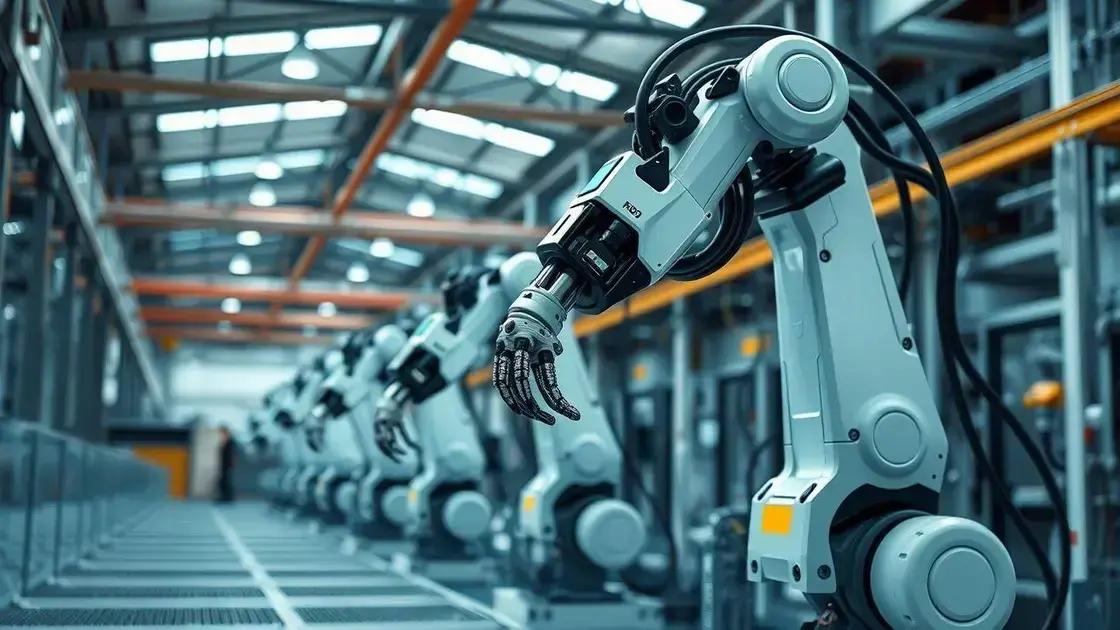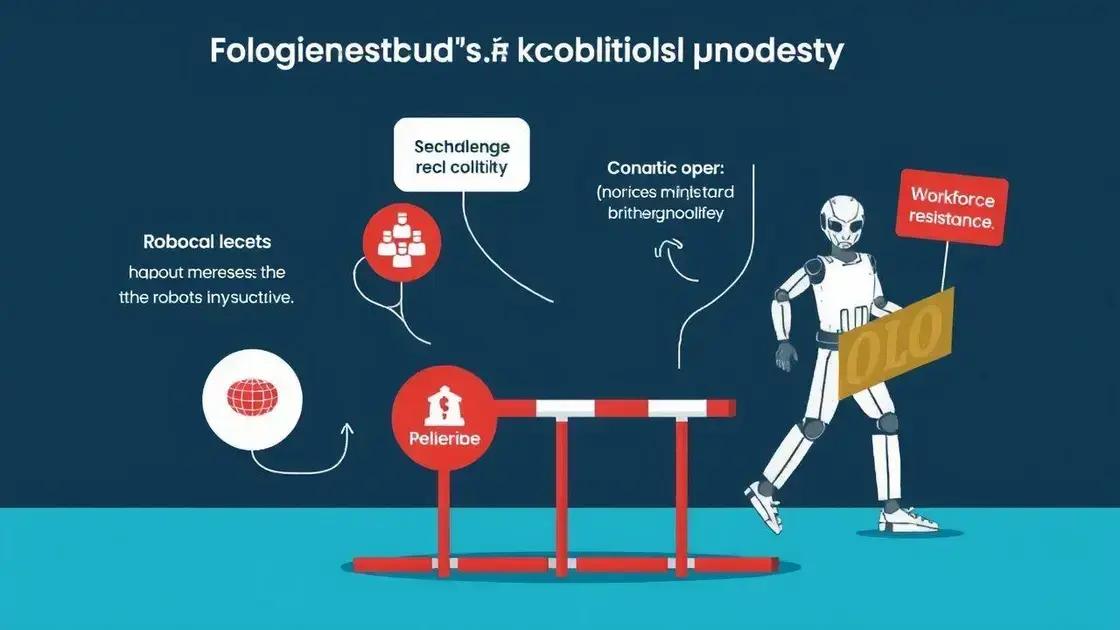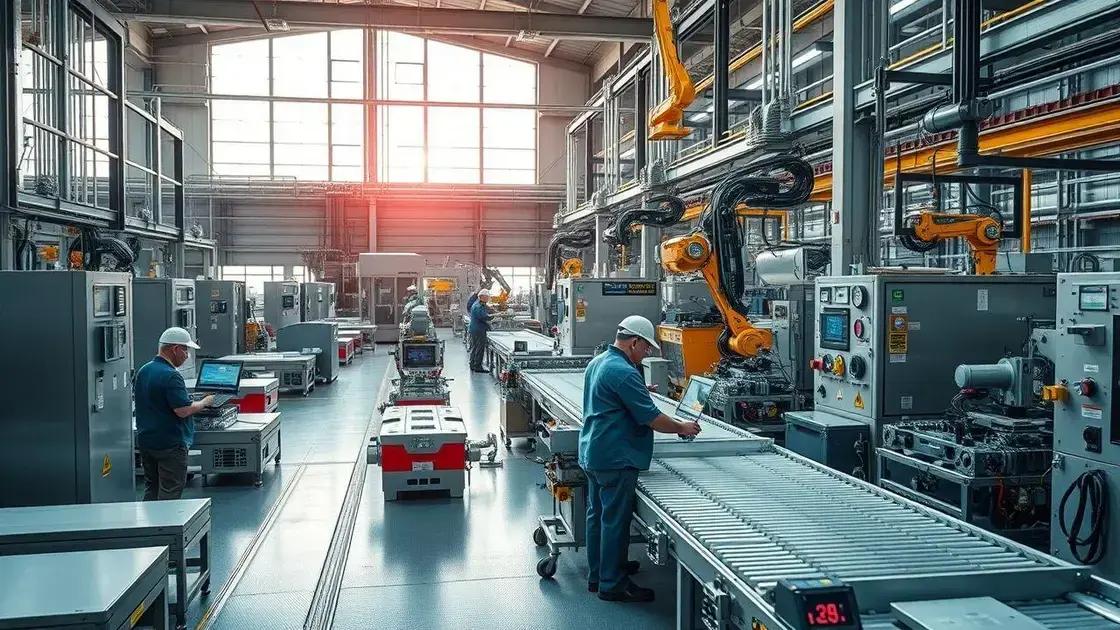Robotics industry expansion: trends driving growth

Anúncios
The robotics industry impacts job markets by displacing low-skill roles while simultaneously creating new opportunities in engineering and data fields, necessitating an adaptation of skills among the workforce.
Robotics industry expansion is happening right before our eyes, transforming everything from manufacturing to healthcare. Have you ever wondered how robots are changing the landscape of these sectors? Let’s dive into this fascinating topic!
Anúncios
Trends in robotics technology
In the rapidly changing world of technology, trends in robotics technology are reshaping industries and creating new opportunities. From advanced artificial intelligence to innovative designs, robotics continues to evolve, making tasks easier and more efficient.
Emerging Technologies
New technologies are leading the charge in robotics, including:
Anúncios
- AI Integration: The use of artificial intelligence in robotics allows machines to learn and adapt to tasks, making them more versatile.
- Collaborative Robots (Cobots): These are designed to work alongside humans, enhancing productivity while ensuring safety.
- 3D Printing: It revolutionizes the way robotic parts are made, reducing costs and manufacturing time.
The integration of these technologies is not just a trend; it’s changing how we think about robots in our daily lives. For instance, cobots are helping in manufacturing processes, allowing human workers to focus on more strategic tasks.
Industry Applications
As robotics technology expands, its applications become more diverse:
- Healthcare: Robots are used for surgeries and patient care, improving outcomes and efficiency.
- Logistics: Automated systems help with inventory management and order fulfillment, reducing human error.
- Agriculture: Robots are utilized for planting and harvesting, increasing yield and reducing labor costs.
These advancements show how significantly robotics influences various sectors, providing tools that can enhance productivity and reduce costs. From improving surgical precision to optimizing supply chains, the impact of robotics is profound.
Furthermore, ethical considerations are emerging alongside these trends in robotics technology. As machines take on more responsibilities, discussions about job displacement and safety are becoming integral to industry conversations. These discussions are vital for ensuring a balanced approach to technological advancement.
Applications of robotics in various industries
The applications of robotics in various industries showcase the versatility and power of robotic technology. As industries evolve, robots are becoming essential tools that help improve efficiency, safety, and productivity.
Manufacturing
In manufacturing, robots streamline processes and enhance production rates. They are used for tasks such as:
- Assembly Line Operations: Robots perform repetitive tasks with precision, allowing for higher output.
- Quality Control: Automated systems check products for defects, ensuring high quality standards.
- Material Handling: Robots transport materials, reducing the risk of injury for workers.
This integration of robotics not only optimizes workflow but also protects human workers from hazardous tasks.
Healthcare
In healthcare, the role of robotics has expanded rapidly. Robots assist in surgeries, enhancing precision and reducing recovery times. They also support:
- Patient Rehabilitation: Robotic devices help patients regain mobility after injuries.
- Medication Management: Automated systems assist in administering medications, ensuring accuracy.
- Telepresence: Robots enable remote consultations, improving access to healthcare.
These applications show how robotics can enhance medical care and patient outcomes.
Agriculture
Agriculture is another area where robotics shines. Robots are increasingly used for:
- Planting and Harvesting: Automation allows for efficient planting and picking, increasing yield.
- Crop Monitoring: Drones and robots gather data on crop health, informing farmers on best practices.
- Pest Control: Robotics can target pests, reducing the need for chemicals.
The integration of robotics in agriculture not only boosts productivity but also promotes sustainable practices.
Across all these sectors, the trend of adopting robotics technology is clear. Enhanced capabilities provide solutions to current challenges, making industries more competitive and innovative. By embracing these advancements, businesses can look forward to a future filled with potential and growth.
Challenges facing the robotics industry

The challenges facing the robotics industry are significant and varied. As robots become more integrated into everyday life and various sectors, several hurdles must be addressed to ensure their effective implementation and acceptance.
Technical Limitations
Despite advancements, robots still face technical challenges. These may include:
- Limited Sensory Perception: Robots often struggle to interpret complex environments like humans.
- Processing Power: The need for faster processing to handle real-time data is essential for advanced robotics.
- Battery Life: Many robotic applications are hindered by limited battery capacity, affecting their operational time.
These technical limitations can restrict the usefulness of robots in critical tasks, making ongoing research vital.
Economic Factors
The robotics industry also faces economic challenges. The cost of developing and deploying robotic systems can be high. Businesses often have to consider:
- Initial Investment: High upfront costs for purchasing and integrating robotic systems can deter companies.
- Maintenance Costs: Ongoing maintenance can add to the overall expense of robotic systems.
- Market Competition: Companies must constantly innovate to keep up with competitors in the tech industry.
These economic factors can impact the speed at which businesses adopt new robotic technologies.
Workforce Resistance
Additionally, there is often resistance from the workforce regarding robotics. Many workers worry about job security, leading to reluctance in embracing these technologies. This resistance includes:
- Job Displacement: Fear that robots will replace human jobs can create backlash against new technologies.
- Lack of Skills: Many workers feel unprepared to work alongside advanced robotic systems.
- Cultural Resistance: Some industries have a traditional approach to work that may resist change.
To address this, education and training programs are essential to prepare the workforce for a future with robotics.
Overall, while the potential of the robotics industry is vast, addressing these challenges is crucial for fostering growth and acceptance. Continuous innovation, understanding economic impacts, and workforce education will play critical roles in overcoming these obstacles.
Future prospects for robotics expansion
The future prospects for robotics expansion are bright and filled with opportunities. As technology advances, robotics will play an even larger role in our daily lives and various industries.
Advancements in Technology
We can expect to see several key advancements that will drive robotics growth:
- Improved AI Algorithms: More sophisticated algorithms will allow robots to learn faster and perform complex tasks better.
- Enhanced Human-Robot Collaboration: Future robots will work alongside humans seamlessly, improving efficiency and safety.
- Miniaturization: Smaller and more compact robots will be developed, enabling use in tight spaces and intricate tasks.
These advancements will not only improve functionality but also make robotics more accessible across different sectors.
Increased Adoption Across Industries
Robots will continue to be adopted in industries beyond manufacturing. Key areas include:
- Healthcare: Robotics will support surgeries and patient care, leading to better outcomes and lower costs.
- Agriculture: Automated farming tools will optimize crop production and reduce labor costs.
- Logistics: Robots will streamline warehouse operations and improve delivery systems.
As industries recognize the value of robotics, we can expect rapid growth and widespread adoption.
Societal Impact
The impact of robotics on society could be transformative. Robots may assist with:
- Daily Tasks: Household robots will take on chores, freeing up time for people to focus on more enjoyable activities.
- Education: Interactive robots can aid teaching, providing personalized learning experiences.
- Emergency Services: Robots will enhance response times and safety during emergencies, performing tasks in dangerous environments.
This potential for improvement in quality of life makes the expansion of robotics a vital topic for ongoing discussions and planning.
Impact of robotics on job markets
The impact of robotics on job markets is a crucial topic as automation continues to grow. Robots are changing the nature of work and creating new dynamics in employment.
Job Displacement
One of the most discussed effects of robotics is job displacement. As robots take over tasks that humans used to perform, certain job roles are at risk. This is especially true for:
- Repetitive Tasks: Jobs that involve routine activities, such as assembly line work, are more likely to be automated.
- Low-Skill Positions: Positions requiring minimal skill and training tend to be replaced by robots.
- Transport and Logistics: Automated systems in warehouses can reduce the need for human workers.
Despite these changes, it’s important to note that not all job displacement is negative. Some roles may evolve rather than disappear.
Job Creation
While some jobs are being lost, robotics also leads to new job creation. This includes a variety of positions in growing fields, such as:
- Robotics Engineering: Skilled engineers design, build, and maintain robotic systems.
- AI and Data Analysis: With increased automation, there is a demand for data scientists to interpret the data generated by robots.
- Training and Support: As companies adopt robotic systems, they need staff to train and support employees in using these technologies.
Thus, while robotics may displace certain jobs, it paves the way for new opportunities that require different skill sets.
Changing Skill Requirements
The need for new skills is a significant outcome of robotics in the job market. As automation becomes more prevalent, workers must adapt. Essential skills include:
- Technical Skills: Understanding how to operate and troubleshoot robotic systems is becoming necessary in many industries.
- Adaptability: Workers need to be flexible and open to learning new technologies.
- Soft Skills: Skills like communication and teamwork are increasingly valued as human-robot collaboration grows.
Overall, the impact of robotics on job markets is complex and multifaceted. While it brings challenges, it also creates opportunities for growth and development.
FAQ – Frequently Asked Questions about Robotics and Job Markets
How does robotics impact job displacement?
Robotics can displace jobs by taking over repetitive and low-skill tasks, which can lead to some workers losing their positions.
What new opportunities does robotics create?
Robotics creates new job opportunities in fields like robotics engineering, data analysis, and training, where skilled workers are necessary.
What skills will be important for future job markets?
Future job markets will require both technical skills to operate robots and soft skills like communication and adaptability to work alongside technology.
How can businesses prepare their workforce for robotics integration?
Businesses can prepare their workforce by providing training programs that focus on new technologies and fostering a culture of continuous learning.






